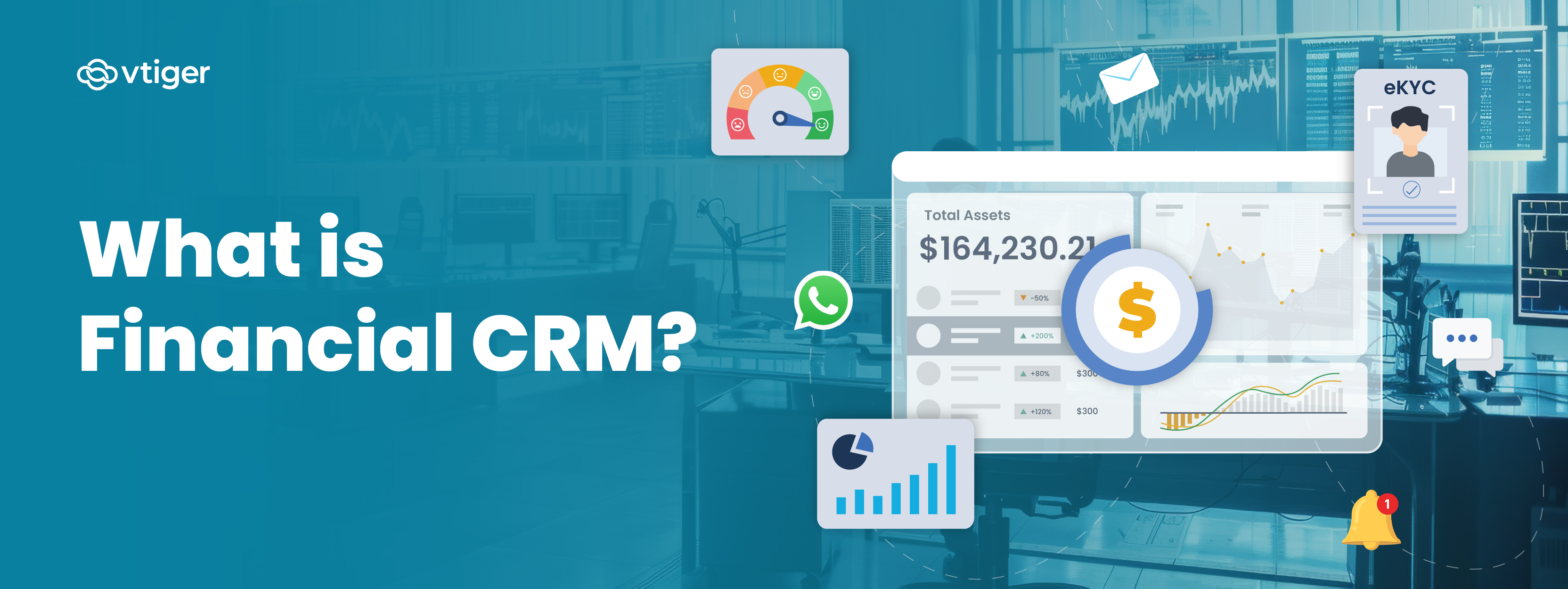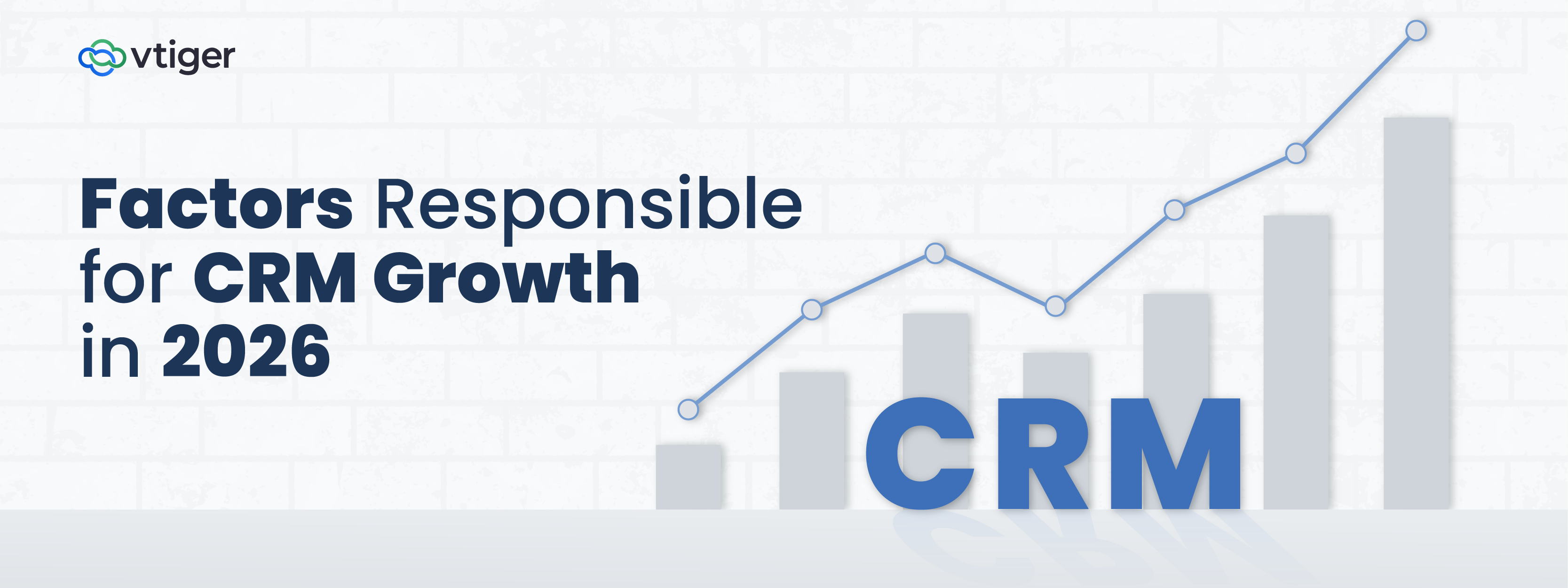Financial institutions deal with high volumes of transactional data, regulatory documentation, and complex customer portfolios. Managing these through spreadsheets or standard CRM software often results in delayed loan approvals, missed compliance deadlines, and inconsistent client service. A financial CRM eliminates these inefficiencies by unifying customer records, automating loan and investment workflows, and enabling regulatory-ready reporting.
Banks, NBFCs, and wealth management firms using financial CRMs report improved lead qualification accuracy, faster credit disbursal cycles, and higher cross-sell ratios, directly impacting profitability and customer lifetime value.
What is financial CRM?
A Financial CRM (Customer Relationship Management) system is a specialized CRM software designed for banks, NBFCs, insurance companies, and wealth management firms to manage client relationships, streamline operational workflows, and maintain regulatory compliance. Unlike generic CRM platforms that cater to broad industries, a financial CRM focuses on processes specific to financial services, such as lead qualification, KYC verification, risk profiling, portfolio tracking, and post-sales service management.
This system consolidates data from multiple sources, including loan applications, investment portfolios, insurance renewals, and customer service interactions, into a centralized client profile. Financial advisors and relationship managers can use these profiles to track financial goals, recommend suitable products, and maintain personalized engagement throughout the client lifecycle.
A financial CRM integrates with core banking systems, payment gateways, accounting tools, and regulatory compliance modules, ensuring uninterrupted data flow and adherence to RBI and PFRDA guidelines. Built-in automation for follow-ups, policy renewals, and upsell or cross-sell recommendations allows financial institutions to optimize sales performance while reducing manual intervention.
Also Read: What is a CRM
Key features of financial CRM
A Financial CRM is designed to address the specific needs of financial institutions, from banks and NBFCs to insurance companies and wealth management firms. Here are the essential features every financial business should look for:
1. Regulatory-Compliant Data Handling
Financial CRMs are built with RBI and SEBI-compliant audit trails, e-KYC verification, and encrypted document storage. Unlike generic CRM software, they maintain transaction-level logs, which simplifies AML (Anti-Money Laundering) checks and internal audits.
2. Priority-Based Lead Allocation
Instead of manually sorting thousands of inquiries, the CRM uses risk profiling and lead-scoring algorithms to rank prospects. High-value leads, such as HNI(High Networth Individual) investment clients or corporate loan applicants, are automatically routed to senior relationship managers, improving conversion rates in regulated financial environments.
3. Investment and Policy Lifecycle Tracking
The CRM links every client to their mutual funds, SIPs, insurance policies, and loan accounts, mapping maturity dates, redemption timelines, and renewal schedules. Advisors receive alerts to suggest portfolio rebalancing or policy upgrades, driving upsell and cross-sell revenue.
4. Multi-Channel Engagement with Compliance Logs
Financial CRMs allow WhatsApp, SMS, and email outreach while storing consent-based communication history. This is essential for meeting data privacy norms and keeping a verifiable record of all financial advice shared with clients.
5. Integrated Portfolio Analytics
The system pulls live data from core banking and trading platforms, generating dashboards that show portfolio performance, NPA (Non-Performing Asset) ratios, and revenue contribution per client segment. Managers can use these insights for targeted product pitches and risk-adjusted advisory.
6. Automated Renewal and Repayment Alerts
Clients receive timely premium, EMI, and maturity reminders through automated workflows. This not only increases collection efficiency but also strengthens retention by showing proactive service.
7. Role-Based Access and Mobile Workflows
Field executives can view only assigned client profiles through mobile apps, while senior advisors get complete 360-degree portfolio views. This ensures data security and operational efficiency, especially for distributed sales teams.
| Further Reading Suggestions | ||
| What is a CRM | Open Source CRM | Sales CRM |
| Evolution of CRM | Analytical CRM | What is a Recruitment CRM |
| What is AI CRM | Mobile CRM | What is the CRM Process |
Benefits of financial CRM
A well-implemented Financial CRM software does much more than store customer data. It changes how banks, NBFCs, insurance providers, and wealth advisory firms manage portfolios, engage clients, and comply with regulatory standards. Below are the key benefits, broken down by operational and revenue impact.
1. Better Lead Management and Upsell Opportunities
Financial institutions deal with a high volume of leads—ranging from retail loan applicants to High Net-Worth Individuals (HNIs) seeking investment advisory. Manual tracking often results in delayed responses and lost revenue.
A Financial CRM uses lead scoring models, risk profiling, and product-interest categorization to prioritize leads. For instance, it automatically tags prospects as “high-value loan”, “low-risk SIP investor”, or “corporate treasury account”, ensuring that relationship managers (RMs) focus on the most profitable segments first.
Upsell and cross-sell become more structured as the CRM maps existing products against customer profiles. For example:
- A retail loan client nearing the end of repayment can be offered a top-up loan or credit card based on repayment history.
- An insurance customer with a term policy can be targeted for ULIP or health insurance upgrades before renewal.
This data-driven approach reduces manual effort and helps financial advisors achieve higher conversion ratios and increased Average Revenue Per Customer (ARPC).
2. A Boost in Customer Engagement
Financial services rely heavily on trust and personalized communication. A Financial CRM consolidates 360-degree customer profiles, including income details, transaction history, and risk appetite, allowing RMs to offer advisory-driven engagement instead of generic pitches.
For example, mutual fund clients receive personalized portfolio rebalancing suggestions aligned with market changes, while loan applicants are sent pre-approved offers based on credit behavior.
Multi-channel engagement through WhatsApp, email, and SMS automation ensures clients receive timely updates on policy renewals, EMI schedules, and market insights. This frequent and relevant communication improves Net Promoter Scores (NPS) and builds long-term loyalty, critical in a sector where repeat investments and renewals drive sustained revenue.
3. Improved Team Collaboration
Financial CRMs eliminate silos between sales, operations, and compliance teams in the following manner:
- Shared Dashboards: Loan disbursal teams can see which files are pending documentation, while sales executives track the same case for follow-ups.
- Task Automation: The CRM assigns tasks automatically such as verification follow-ups for new loan applicants or KYC document checks for new investors, ensuring no manual miscommunication between departments.
- Role-Based Access: Branch managers can track branch-level performance, while relationship managers view only their assigned portfolios, maintaining data security.
This structured flow reduces turnaround time for loan approvals, insurance issuance, and investment advisory, directly improving operational efficiency.
4. Secure Customer Data Management
Data security is a critical concern for financial institutions due to RBI, SEBI, and IRDAI regulations. Financial CRMs are built with:
- End-to-end encryption for sensitive financial data such as bank account details and investment portfolios.
- Audit trails to record every client interaction, ensuring easy regulatory audits.
- Compliance with AML (Anti-Money Laundering) and KYC norms, reducing the risk of penalties.
5. Better Sales Performance
Sales teams in financial institutions face pressure to deliver faster closures and higher conversion rates. A Financial CRM improves sales outcomes in several ways:
- Automated Follow-Ups: Missed follow-ups are a major cause of lost deals. The CRM triggers automated reminders for loan document submission, insurance premium payments, or investment maturity discussions.
- Pipeline Visibility: Managers can view deal stages, identify bottlenecks (like delayed KYC approvals), and allocate resources accordingly.
- Predictive Analytics: By analyzing historical sales patterns, CRMs forecast which products perform better in specific segments, allowing teams to prioritize profitable offerings.
As a result, deal closure time reduces significantly, and sales productivity improves, especially for NBFCs and wealth management firms operating in competitive markets.
6. Accessibility Across Devices
Field teams, especially in insurance and NBFCs, spend most of their time meeting clients or conducting on-site verifications. A mobile-compatible Financial CRM ensures:
- Real-time data entry: RMs can update meeting notes, KYC document collection status, or loan application progress on the go.
- Instant access to client portfolios: Advisors can pull up investment or policy details during client meetings, improving credibility and decision-making speed.
- Branch-level synchronization: Updates made on mobile instantly reflect in the central CRM, preventing duplication of work.
This anytime-anywhere accessibility is critical for financial firms scaling operations across Tier 2 and Tier 3 cities, where field visits dominate sales cycles.
7. Faster Loan Disbursal and Reduced TAT
A distinct advantage of financial CRMs is workflow automation for loan and insurance approvals. The CRM integrates with credit bureaus, banking APIs, and e-sign tools, reducing manual verification delays. For example:
- Loan eligibility checks are run automatically using credit score integrations, reducing human errors.
- Automated document verification speeds up sanctioning processes, allowing NBFCs to meet the increasing demand for instant personal loans and vehicle financing.
This directly translates into better customer satisfaction scores and helps financial firms compete with fintech players offering quick approvals.
8. Enhanced Reporting and Compliance Audits
Regulatory compliance is one of the most resource-heavy functions in financial businesses. A Financial CRM simplifies this through:
- Custom Compliance Reports: Automated generation of AML, KYC, and portfolio risk reports for internal and external audits.
- Transaction History Logs: Every update, whether a policy change, loan sanction, or portfolio rebalance, is stored with time stamps.
- Automated Alert Mechanisms: Compliance teams receive notifications for overdue KYC renewals or unusual transaction patterns, reducing the chances of non-compliance penalties.
This reduces audit preparation time and enhances transparency, which is vital for maintaining regulatory credibility.
9. Improved Customer Retention
Retention is as important as acquisition in financial services, where repeat business drives recurring revenue. A Financial CRM ensures retention through:
- Proactive Service: Clients receive timely alerts for policy renewals, SIP top-ups, and loan repayment schedules.
- Customer Health Scoring: The system identifies clients who might churn due to inactivity or portfolio underperformance, allowing RMs to engage them early.
For example, an HNI portfolio showing declining returns triggers an advisory meeting request, demonstrating proactive service and reducing the risk of losing high-value clients to competitors.
Conclusion
The future of financial CRM software lies in how well it aligns with adaptive financial services models. With open banking, AI-led credit scoring, and digital-first lending ecosystems becoming mainstream, CRMs that can integrate with core banking systems, API-driven payment platforms, and regulatory monitoring tools will define competitive advantage.
Financial institutions should view CRM as a growth infrastructure rather than a sales add-on. Those still relying on fragmented databases or legacy tools will face rising compliance risks and slower response times. Choosing a CRM that supports AI-based portfolio insights, multi-channel client engagement, and strong data governance frameworks is no longer optional, it is becoming the standard for financial institutions aiming for scalable and compliant growth.
Frequently Asked Questions
What is Financial CRM and how does it help financial institutions?
A financial CRM is specialized customer relationship management software designed for banking, NBFCs, and advisory firms. It organizes all client information—KYC records, investment preferences, and loan history—into a centralized platform. Automated lead scoring, follow-up reminders, and compliance alerts streamline operations. Institutions using financial CRMs often see faster loan approvals, higher cross-sell conversions, and improved regulatory audit readiness.
What are the key benefits of using Financial CRM?
Financial CRMs drive measurable growth by combining automation with analytics. They enable banks to track every lead through a structured pipeline, identify high-value clients for cross-selling, and deliver personalized wealth advisory services. Automated document verification and task routing reduce processing errors. Additionally , built-in compliance logs meet RBI audit requirements, while real-time dashboards reveal market trends, improving lending and investment decisions.
What features should you look for in a financial CRM for your business?
Look for role-based security, end-to-end encryption, and real-time reconciliation with core banking or portfolio management systems to avoid data gaps. Customizable reporting for loan disbursement rates, sales closure timelines, and portfolio performance is crucial. Mobile-first access helps relationship managers update client data from the field, while automated workflows for KYC renewal, EMI reminders, and policy renewals save significant manual effort.
How does Financial CRM help wealth managers and financial advisors?
Wealth managers use financial CRM to map every client’s financial goal, portfolio risk profile, and past transactions. Automated portfolio review alerts and compliance tracking free up advisory teams from routine tasks, allowing them to focus on personalized investment strategies. This also ensures higher retention as clients receive proactive advice on portfolio rebalancing or upcoming market opportunities.
Are there specific regulations that need to be considered when implementing Financial CR?
Yes, compliance with RBI and PFRDA regulations is mandatory. CRMs must support audit trails for every financial interaction, AML checks, and secure storage of KYC and CDD data. Systems with consent tracking, two-factor authentication, and encrypted data backups meet most financial security requirements.
What are the challenges faced by financial institutions when implementing CRM?
Many institutions struggle with migrating fragmented legacy data, ensuring data quality for KYC records, and integrating CRMs with old banking software. Lack of staff training delays adoption. Opting for CRMs with financial sector-ready APIs and pre-built workflows can minimize these operational bottlenecks.
How can small and medium-sized enterprises (SMEs) benefit from Financial CRM?
SMEs benefit by automating loan and policy renewal reminders, reducing dependency on manual trackers. Real-time analytics highlight clients with high repayment consistency, enabling targeted upselling. Compliance-ready workflows help SMEs maintain RBI audit readiness without dedicated IT teams.
How can Financial CRM improve customer service in banks?
Every interaction, whether related to loan restructuring, EMI payments, or dispute resolution, is recorded in one system, allowing bank staff to respond quickly. Predictive alerts for policy renewals or matured deposits enable proactive communication, improving trust and repeat banking relationships.



